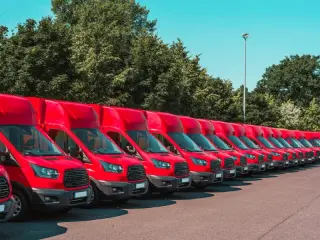
The ground beneath fleet operations is shifting faster than most managers expected. New tech, tighter sustainability rules and changing driver markets mean 2026 will be a year where fleets either accelerate or fall behind. If you manage vehicles, drivers or fuel budgets, these are the trends to know and the practical actions you should be preparing for right now.
Below you’ll find the biggest fleet-management trends for 2026, why they matter, and how to turn them into an advantage. Expect to see recurring themes: more data, smarter use of that data, faster electrification, and a bigger role for AI in fleet management for everyday decisions.
1. Electric fleets move from “nice to have” to core strategy
Why it matters: Electric vehicle (EV) adoption is accelerating and charging infrastructure is catching up, but unevenly. That means fleets that plan their charge strategy now will be the ones who avoid last-minute costs and downtime.
What to watch in 2026
Faster fleet electrification across urban and last-mile operators as the total cost of ownership converges with diesel.
Continued rollout of public and workplace chargers, the UK public charging network is expanding rapidly, making longer commercial routes more viable.
Action points for fleet managers
Map routes by charger availability and add contingency chargers to critical routes.
Start pilots with EVs on clearly defined routes (urban delivery, short-run services) to build charging routines, driver training and realistic TCO figures.
Use EV charge cards and aggregated invoicing to centralise EV spend and simplify VAT/accounting.
2. Telematics + fleet data become non-negotiable
Why it matters: Fleet telematics moves beyond simple location tracking. Today, it’s the foundation for route optimisation, driver coaching, emissions reporting and predictive maintenance.
Market signals: Telematics adoption and spend continue to grow as businesses demand real-time fuel, mileage and utilisation data. This market growth underlines why “data-driven fleet management” is no longer optional.
How to use it
Treat telematics and fuel-card reporting as a single source of truth: correlate fuel consumption with routes, idling, speeds and driver behaviour.
Build KPIs from the data - cost per mile, utilisation rate, idling minutes - and make weekly reviews routine.
Integrate telematics with your accounting and maintenance systems so alerts trigger work-orders and budget flags automatically.
3. Predictive maintenance cuts downtime and cost (real savings)
Why it matters: Reactive maintenance is expensive. Predictive maintenance powered by telematics, sensors and AI spots problems before they fail, cutting unscheduled downtime and reducing costs.
What the research shows: predictive maintenance programs can reduce maintenance costs and increase uptime substantially, with real-world fleets reporting big reductions in unscheduled downtime.
How to implement it
Start with high-value assets and fault-prone components (turbochargers, batteries, key drivetrain parts).
Use your telematics provider or maintenance partner to set alert thresholds (vibration, temperature, fuel usage anomalies).
Move from calendar-based servicing to condition-based servicing and track the ROI.
4. AI moves from dashboards into decision-making
Why it matters: AI is no longer just a buzzword; it’s being used to optimise routes, forecast demand, schedule maintenance, and detect fraud. A data-driven fleet gets smarter every month.
Concrete examples for 2026
AI-driven route optimisation that factors traffic, charger locations, customer windows and vehicle range.
Automated anomaly detection for fuel or card spend (flagging likely fraud or inefficiency before it costs you).
Demand forecasting that helps trim fleet size or allocate vehicles optimally.
Practical steps
Ensure your data is clean and structured. AI only works well on good data.
Start with one use case (route optimisation or anomaly detection) and scale once you have measurable gains.
Treat AI outputs as recommendations, not directives. Combine outputs with human oversight.
(For many fleets, 2026 will be the year AI moves from “nice to have” to “mission critical”.)
5. Autonomous tech and platooning: targeted gains now, bigger shifts later
Why it matters: Fully driverless trucks are not yet the norm, but platooning, advanced driver assistance systems (ADAS) and remote-supervised operations are gaining traction. These reduce fuel burn, improve safety and open new operational models for long-haul fleets. Trials and pilots are expanding across Europe and the UK.
What to do now
Monitor trials and regulatory changes, be ready to pilot platooning on long, consistent routes.
Invest in ADAS and lane-assist tech now: safety and fuel savings come immediately.
Begin workforce planning for new skills (tele-operators, remote monitoring engineers).
6. Sustainability: carbon reporting and customer expectations
Why it matters: ESG reporting is increasingly required by customers and investors. Fleets that can show measured reductions in CO₂, NOx and particulate emissions will win contracts and avoid penalties.
How to act in 2026
Use telematics and fuel/charge data to produce accurate CO₂ outputs per job, route and vehicle.
Publish simple sustainability KPIs to customers (kg CO₂ per delivery, % zero-emission miles).
Prioritise electrification where it gives the biggest emissions drop (urban fleets, last mile, predictable routes).
7. Workforce pressures force smarter retention and training
Why it matters: Driver shortages continue to bite, and competition for skilled technicians is fierce. Investing in training, better rostering, and wellbeing improves retention and reduces error rates.
Quick wins
Use data to build fair, efficient rotas and reduce fatigue risks.
Offer targeted upskilling (EV charging, battery safety, ADAS operation).
Tie bonuses to efficiency and safety metrics, not just mileage.
8. Cybersecurity and data governance get real budgets
Why it matters: Connected fleets are rich targets. A compromised telematics system can expose routes, customer data and payment systems. Expect insurers and large customers to demand clear security controls in 2026.
Checklist for 2026
Two-factor authentication and role-based access for telematics and fuel platforms.
Regular penetration testing and supplier security assessments.
Policies for data retention and GDPR compliance.
9. New commercial models: subscriptions, on-demand capacity and MaaS
Why it matters: Fleets will increasingly experiment with flexible capacity models, vehicle-as-a-service, subscription vans, and on-demand hire to match capacity to peak demand without heavy capex.
How to explore it
Run small pilots that mix owned and leased/subscription vehicles.
Model the impact on cash flow, maintenance and insurance.
Use data to determine which vehicle types are best kept on subscription vs owned.
Final thoughts: what to do this quarter
Audit your data - if you can’t report cost per mile accurately in under a day, start there.
Pick one AI/telemetrics pilot - route optimisation or anomaly detection are high-value starts.
Plan charging infrastructure for routes that make the biggest cost and emissions impact.
Invest in training for EVs and ADAS - early upskilling pays off.
Treat cybersecurity seriously - it’s now a board-level operational risk.
2026 won’t be gentle to fleets that procrastinate. But it’s an enormous opportunity for operators who use fleet data, automate the right tasks, and make electrification and AI work together. Start small, measure everything, and scale the projects that deliver cost and safety wins; that’s how fleets will outperform competitors next year.
Sources and further reading
UK electric vehicle charging device statistics and rollout. (UK Parliament Committees)
Market growth and adoption trends for telematics and fleet software. (Grand View Research)
Predictive maintenance impact and savings research. (fieldex.com)
Global Webfleet research on fleet managers’ expectations for AI and EVs. (Bizcommunity)
Trials and research into platooning and automated freight trials in the UK. (GOV.UK)



